June 2006 LIP of the Month
Corresponds to event #40 in LIP Record database.
Permian large volume basalts in Tarim basin
Shufeng Yang, Zilong Li, Hanlin Chen, Chuanwan Dong, Xing Yu
Department of Earth Science, Zhejiang University, Hangzhou 310027, P. R. China
Chengzao Jia, Guoqi Wei
PetroChina, Beijing 100011, P. R. China
E-mail: yjsy-ysf@sun.zju.edu.cn (to Dr. S.F. Yang) or zilongli@zju.edu.cn (to Dr. Z.L. Li) or hlchen@zju.edu.cn (to Dr. H.L. Chen)
Extracted mainly from Yang et al. (2005a, 2006a, b, c, and 2006d in preparation) in the reference
Abstract
The large-scale Permian magmatism in the Tarim basin is linked with mantle plume activity and mass extinction. The voluminous Permian basic volcanic zone consists mainly of basaltic rocks and diabases with minor basaltic andesites, ultramafic rocks and syenites. The total area covered by the Permian basic igneous rocks is more than 200,000 km2, and columnar jointing of basalts in some sections is well-developed. 40Ar-39Ar and zircon SHRIMP U-Pb age dating yield 282-290 Ma for basalts and 277 Ma for the syenite, respectively. The basalts and diabases have compositions of tholeiite and alkali basalt series, and display high LILE and LREE concentrations, have no Nb-Ta anomalies. These and additional tectonic discriminative diagrams indicate that the magmatism formed in a within-plate extensional setting and was derived from an enriched mantle source that includes a plume component. The magmatism is located in the interior of the Tarim basin, and therefore has an intracontinental setting. At this time, the Tarim basin was undergoing extension in a back arc setting related to the subduction of Paleo-Tethys ocean crust under the Tarim plate. The existence of three short magmatic pulses in Asia at 280 (Tarim), 258 (Emeishan) and 250 Ma (Siberian Trap), would seem to indicate three discrete LIP events as discrete plumes arising from the same broad region of deep mantle.
1. Introduction
The Tarim basin being the largest basin in China, records a long tectonothermal history ranging from 2,500 Ma to 270 Ma. It is surrounded by the Tianshan, Kunlun and Altun orogenic belts (Fig. 1), mainly consists of Precambrian basement and Phanerozoic strata, and can be divided into four major tectonothermal events: Neoproterozoic (774-673 Ma), Ordovician (460-484 Ma), Permian (260-292 Ma) and Cretaceous (ca. 100 Ma) (Yang et al., 1997; Yang et al., 2005a). Among these, the Permian geological event was the largest one with respect to magmatic scale and spatial distribution. The Permian rocks in the Tarim basin mainly consist of volcano-sedimentary sequences, limestone and basic- to intermediate-acidic- volcanic rocks and related igneous rocks. Through systematic field mapping, analysis of drill-core records, geophysical investigations and geochemical/isotopic data, the Permian magmatism has been divided into two zones: an intermediate-acidic igneous zone in the north and a basic volcanic zone in the central-western part of the Tarim basin (Yang et al., 2005a); the latter formed earlier than the former. These two zones may have no genetic linkage, and are provisionally regarded as two separate suites. The intermediate-acid igneous rock zone consists of andesite, rhyolite, granodiorite, granite, granophyre and tuff, and their isotopic ages range from 288 to 246 Ma. The voluminous Permian basic volcanic zone consists mainly of basaltic rocks and diabases with minor basaltic andesites and syenites, showing an age concentration around 260-292 Ma (Table 1). Jia (1992) reported large diabase dyke swarms with NNW-SSE trend and steep dips, which intruded into Silurian, Devonian, Carboniferous and Early Permian units, as recorded from outcrops, and into Silurian and Devonian units, as observed in some drill cores. These dykes yielded Sm-Nd ages of 259±57 Ma (Table 1). The Xihaizi bimodal dyke in Bachu area was discovered recently (Yang et al., 2006b).
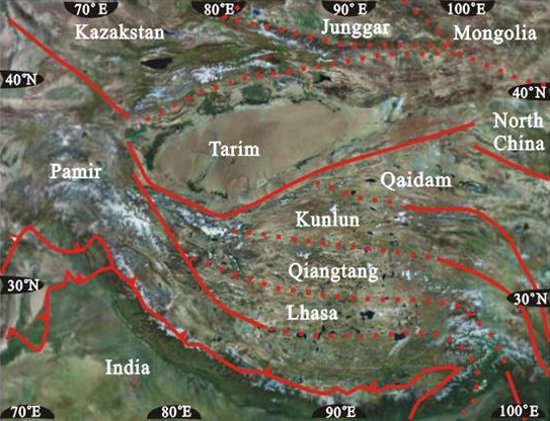
Figure 1: Remote sensing image showing location of Tarim basin and surrounding tectonic divisions.
| Sampling Sections | Stratum (Formation) | Lithology | Methods | Results (Ma) | References |
| Bachu | diabase | Sm-Nd | 259±57 | Jia (1992) | |
| Bachu | syenite | Ar-Ar | 277±1.3 | Yang et al. (1996) | |
| Yigan (different layers) | Kupukuziman | basalt | K-Ar |
289.0±6.1a; 272.9±4.0a; 288.4±4.4a; 287.2±5.6b |
a Zhang et al. (2003); b Yang et al. (2005a) |
| Taxinan | Qipan | basalt | K-Ar | 289.6±5.6 | Yang et al. (2005a) |
| Sishichang | Kupukuziman | basalt |
K-Arc,d; Ar-Are |
292.4±0.5c; 278.5±1.4d; 278e |
cLiu (1991); dYang et al. (1996); eJia (1992) |
| Kaipaizilaike | Kaipaizilaike | basalt | K-Ar | 259.8±0.9 | Liu (1991) |
Table 1: Geochronological data of the Permian basalt, diabase, and syenite from the Tarim basin
Note: some age data are from Yang et al. (2006a).
The large scale Permian magmatism in the Tarim basin is linked with mantle plume activity and mass extinction, and the ascending magma interacted with continental crust (Yang et al., 1996; Chen et al., 1997; Yang et al. 1997; Jia et al. 1997; Jiang et al., 2004a, b; Yang et al., 2005a, b). An important unsolved question is the link between the Tarim Permian ca. 280 Ma magmatism and other Permian mafic magmatic events in surrounding regions, such as the 250 Ma Siberian traps, and the 258 Ma Emeishan large igneous province in SW China.
In order to improve the understanding of the evolutionary history of the Permian magmatic event in the Tarim basin, this report shows the spatial and temporal distribution of the magmatism, presents geochemical data for the basalts, and evaluates the geodynamic implications for this important magmatic event in the Tarim basin during the Permian.
2. Spatial distribution of Permian basalts from Tarim basin
Large volumes of Permian basalts and related igneous rocks (260-292 Ma) are widely distributed in the Tarim basin. The magmatism consists mainly of basalts, diabases, basaltic andesites, ultramafic rocks and syenites. The total area covered by the Permian basic igneous rocks is more than 200,000 km2 (Fig. 2) with the thickness of basalt layers ranging from several tens of meters to more than five hundred meters (Yang et al., 2005a). A remote sensing image shows the spatial distribution of the Permian basalts and sedimentary stratum in the Aksu-Keping area of Tarim basin (Fig. 3).

Figure 2: Tectonic sketch map of Tarim basin and study area

Figure 3: Remote sensing image showing Kaipaizileike and Kupukuziman formations in northwestern Tarim basin.
Permian strata in Fig. 3 can be divided into the Kupukuziman and overlying Kaipaizileike formations (lower to middle and middle Permian, respectively). They mainly outcrop in the Dawangou, Yigan, Kaipaizileike and Sishichang sections (Fig. 2). Columnar jointing of basalts in the Kaipaizileike section is well-developed (Fig. 4). Two basalt layers of the Kupukuziman formation can be seen in the Sishichang section (Fig. 4), and six basalt layers of the Kaipaizileike formation are also observed interlayered with Permian fluvial sedimentary rocks. No.10 spatial section line shows well-developed Permian basic volcanic rocks (basalt) with a thickness of 530 m, and the drilling wells of He 4# and Tazhong 22# reveal great thickness of 460-530 m of the basalt, respectively (Fig. 5).
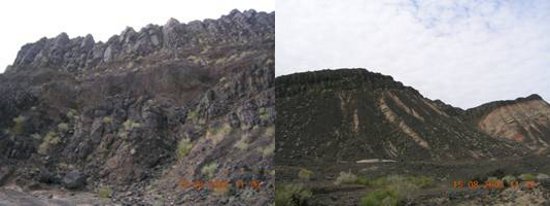
Figure 4: Columnar jointing in basalts in the Kaipaizileike section.

Figure 5: No. 10 spatial section line shows well-developed Permian basic volcanic rocks (basalt) with a thickness of 530 m (Yang et al., 2006d, in preparation).
The Yingan section is located in the northwestern part of the Tarim basin (Fig. 2) and a field orientation (strike/dip) of basalt layers is 180°/44°. The basalt layers have a total thickness of ca. 530 m in this section except for small amounts of intercalated Permian sedimentary layers composed of mudstones, siltstones, and mud-bearing limestones. The Damusi section occurs in Yecheng County of the southwestern part of Tarim basin (Fig. 2), and massive basalt layers are interlayered in the middle part of the Early Permian Qipan formation which have an orientation (strike/dip) of 220°/50° and thickness of approximately 42 m.
Permian Xiaohaizi syenite and dikes are well-developed in the Xiaohaizi, east Bachu area in the northwestern Tarim basin. In the Bachu area of NW Tarim basin, the dyke association is well developed with diabases, ultramafic rocks, and quartz syenitic dykes and a syenite batholith intruded into the Silurian, Devonian, and Carboniferous-Lower Permian strata. The majority of the dykes have NW-NNW trend with vertical dips and were emplaced during the Early Permian. Closely packed diabase dykes trending N70o outcrop in the Bachu Shuigongtuan area and intrude into Devonian strata. In one of the outcrops, a purple quartz syenitic porphyry dyke with an approximately 1-2 m width occurs in direct contact with dark-bluish diabase dyke in the Shuigongtuan area. Both of the dykes show a NE strike and steep dip (55°/78°). The dyke rocks are surrounded by the Devonian strata (Fig. 6). The diabase dyke swarms in the western Tarim basin intruded into the sedimentary strata during Early Permian, however, they did not intrude into the Kupukuziman formation with its basaltic layers, indicating that the diabase formed in Early Permian and was emplaced earlier than those basalts of the Kupukuziman formation.
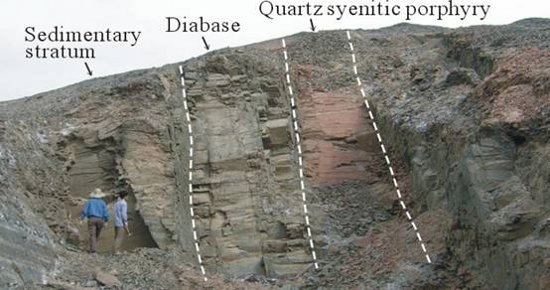
Figure 6: Field contact relationship between the diabase and syenitic dykes (Yang et al., 2006b).
3. Temporal distribution of Permian basalts from Tarim basin
Because the previous age data obtained for the Permian basalts and igneous rocks were poor, 40Ar-39Ar and zircon SHRIMP U-Pb age dating were carried out on basalts and syenite from the northwestern and southwestern parts of Tarim basin, respectively.
Samples Yg20-21 and Txn25-21 for the 40Ar-39Ar age dating were from the third basaltic layer from the bottom of the four basaltic layers of the Yingan section, and from the interlayer of the Damusi section. The two samples have a groundmass with microlites of plagioclase, clinopyroxene and iron oxides with small amounts of olivine. The groundmass has intersertal and crytocrystalline textures, and massive structures. 40Ar-39Ar dating on whole-rock basalts from the Yingan section yielded a plateau age of 281.8±4.2 Ma (2σ) and anti-isochron age of 282.5±4.4 Ma (2σ) for sample Yg20-21, and a weighted mean value of 290.1±3.5 Ma for sample Txn25-21 (Yang et al., 2006a) (Fig. 7). The age data from the Kupukuziman and Kaipaizileike basalts were concentrated at 258-288 Ma with a mean value of 272 Ma, while the Kupukuziman basalts were concentrated in 278-292 Ma with a mean value of 285 Ma. A zircon SHRIMP age of 277 Ma from the Xiaohaizi syenite was reported recently (Yang et al., 2006b).
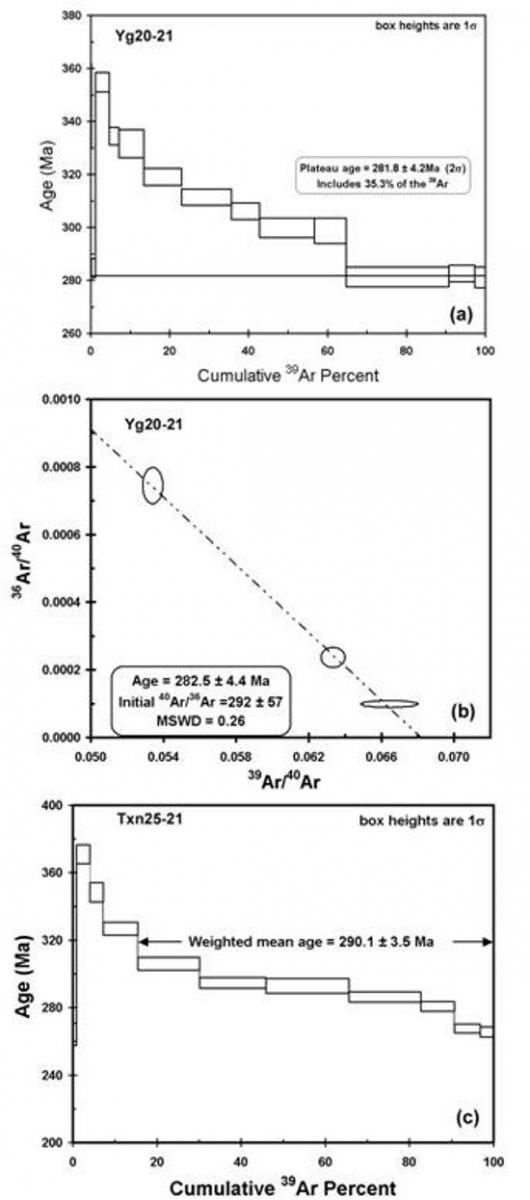
Figure 7: 40Ar/39Ar stepwise incremental heating measured results: (a) a plateau age of Yg20-21 from the Yigan section; (b) an isochron age of Yg20-21 from the Yigan section; and (c) a weighted mean age of Txn25-21 from the southwestern part of the Tarim basin (Yang et al., 2006a).
4. Geochemical and isotopic characteristics of basalts and related igneous rocks
The basaltic and diabase samples have compositions belonging to both the tholeiite and alkali basalt series in the SiO2-Zr/TiO2 classification diagram (Fig. 8), and formed in a within-plate extensional setting based on tectonic discriminative diagrams such 2Nb-Zr/4-Y (Fig. 9). The basalts display high K, Rb, Ba, Th, LILE and LREE concentrations, high LREE/HREE ratios, negative Eu anomalies and have no Nb-Ta anomalies (according to spider diagrams of Fig. 10). They are derived from an enriched mantle source based on Zr-Y and Zr-Nb diagrams (Fig. 11). Sr-Nd-Pb isotopic results group as εNd(t) = -1.73 to -3.69, εSr (t) = 27.56 to 56.87, 206Pb/204Pb = 17.87-18.02, 207Pb/204Pb = 15.45-15.53, and 208Pb/204Pb = 38.22-38.49 (Jiang et al., 2004b). Jiang et al. (2004b) argued that the Nd, Sr and Pb isotopic compositions from the Keping basalts were derived from the Precambrian enriched-type continental lithospheric mantle. This lithospheric origin may be applied to all the well-developed mafic magmatic rocks in the Tarim basin and its peripheral areas.

Figure 8: SiO2-Zr/TiO2 classification diagram of Permian basalts and diabases from Tarim basin.
Note: Red: basalt samples from outcrop; blue: basalt samples from drill core; and green: diabase samples (Yang et al., 2006d, in preparation).
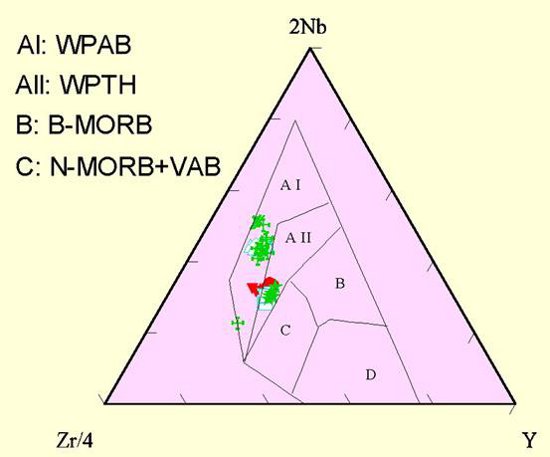
Figure 9: 2Nb-Zr/4-Y diagram of basalt and diabase samples showing within-plate environment
Note: The symbols are the same as Fig.8 (Yang et al., 2006d, in preparation).

Figure 10: MORB normalized spider diagram of basalt and diabase samples showing within-plate environment (Yang et al., 2006d, in preparation).
Note: The symbols are the same as Fig.8.
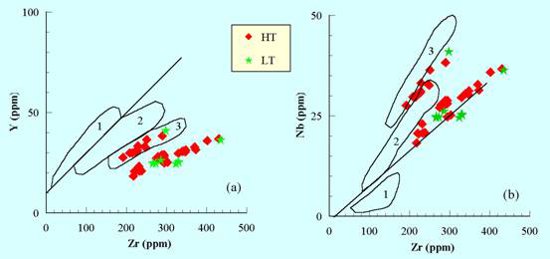
Figure 11: Low Ti (LT) and high Ti (HT) types of basalts fall in the field of enriched mantle and vicinity in Zr-Y and Zr-Nb diagrams (Yang et al., 2006d, in preparation).
Note: enriched mantle source; 1: depleted mantle; 2: transitional mantle; 3: enriched mantle.
The syenite body and dikes have close genetic relationship with each other. Both are high in LILE (such as K, Rb and Ba) and HFSE (such as Th and Ta). The syenite and dikes have similar REE patterns showing significant LREE enrichment. The quartz syenite porphyry in the dyke has high Zr, Hf, Ba, Sr, Rb, Nb, Y, LREE and Ga/A1 ratios, with low P and Ti contents, and negative Eu anomaly (Yang et al., 2006b) being comparable with A-type granites. Tectonic discriminative diagrams and trace element spider diagrams indicate that the quartz syenitic porphyry, syenite and diabase all formed in a within-plate setting. The Th/Hf vs. Ta/Hf diagram shows the diabase samples plotting in a field between enriched mantle and mantle plume, therefore suggesting a plume component in the mantle source area. However, the primary chemistry was probably modified during magmatic ascent to upper crustal levels. Based on petrological and geochemical characteristics, it is reasonable to conclude that the syenite body and peripheral dikes were derived from the same magma source.
5. Geodynamic implications of Permian large volume basalts in Tarim basin
The geochemical features combined with discriminative tectonic diagrams indicate that the basalts erupted in continental within-plate setting. Geochemical and Nd isotopic characteristics suggest that the basalts were probably derived from an enriched lithospheric mantle reservoir by partial melting (Yang et al., 1997; Jiang et al., 2004b; Yang et al., 2005a). Based on low Y/Nb values, enrichment in LILE and HFSE, and uniform Nb-enrichment patterns in spider diagrams for the quartz syenitic porphyry, together with the geochemical patterns of the diabases, we interpret this bimodal association to be derived from a mantle source that formed under a typical within-plate environment (Yang et al., 2006b). Zhang et al. (2003) argued that the Kupukuziman and Kaipaizileike formations were formed during the lower to middle and middle Permian based on paleontological and sedimentary evidence. A combination of data from the present study together with those of Yang et al. (1997) and Chen et al. (1997), suggest that the Tarim basin experienced a major tectonothermal event in the Permian, with strong imprints in the central and western parts of the basin. The presence of a suite of magmatic rocks formed in an intraplate environment implies that a large intracontinental setting developed in the interior of the Tarim basin during the Permian. The Tarim basin was then under the control of extension which was probably related to a back arc setting to the subduction of Paleo-Tethys ocean crust beneath the Tarim plate.
The large volume Early to Middle Permian magmatic event in Paleo-Tethys district occurred in the Tarim basin, and adjacent areas of Turpan-Hami basin, Hongliuhe area, Beishan area (Yang et al., 2005b). Even the 258 Ma Emeishan basalt of the western margin of the Yangtze plate (Chung and Jahn, 1996; Xu et al., 2001), is intimately related to Paleo-Tethys ocean evolution. The basalts linked with the PaleoTethys district, include not only those of the Tarim basin, and the Emeishan field of the western Yangtze plate, but also those from the southern and northern margins of Tethys orogenic belt.
With the new data from the Tarim event, it is now possible to consider genetic links among the Tarim (280 Ma), Emeishan (258 Ma) and Siberian events (250 Ma) (R.E. Ernst, personal communication, 2006): The existence of three short magmatic pulses at 280, 258 and 250 Ma would seem to indicate three discrete events in the source region, and it is reasonable to infer that all three discrete LIP events originated as discrete plumes arising from the deep mantle. However, the broad spatial grouping of these three major plume/LIP events within a 30 Ma year period strongly suggests a genetic link, and it can be inferred that all three are related to a single protracted regional thermal/compositional anomaly in the same broad region of the deep mantle.
Acknowledgement
The authors greatly appreciate R.E. Ernst (Canada) for encouragement and critical review on this report, and are also grateful to the Key Isotopic Laboratory, Institute of Geology, Chinese Academy of Geological Sciences, and Key Laboratory of Isotopic Geochronology and Geochemistry, Guangzhou Institute of Geochemistry, Chinese Academy of Sciences, and the Beijing SHRIMP Center, China. This research was funded by the NSFC (40472040, 40472120) and National Key Project for Basic Research (2001CB409801).
References
Chen, H.L., Yang, S.F., Dong, C.W. et al. 1997. The discovery of early Permian basic rock belt in Tarim basin and its tectonic meaning. Geochemica 26(6): 77-87 (in Chinese with English abstract).
Chung, S.L. & Jahn, B.M. 1995. Plume-lithosphere interaction in generation of the Emeishan flood basalts at the Permian-Triassic boundary. Geology 23: 889-892.
Jia, C.Z., Yao, H.Q., Gao, J., Zhou, D.Y., Wei G.Q. 1992. The stratum system of Tarim basin. Tong, X.G. and Liang, D.G. (Eds. in chief). The article volume of oil and gas exploration of the Tarim basin. Urumq: Xinjiang Scientific, Technology and Sanitation Press (in Chinese).
Jia, C.Z. 1997. Tectonic characteristics and oil-gas, Tarim basin, China, Beijing, Petroleum Industry Press (in Chinese).
Jiang, C.Y., Zhang, P.B., Lu, D.R. &Bai, K.Y. 2004a. Petrogenesis and magma source of the ultramafic rocks at Wajilitag region, western Tarim Plate in Xinjiang. Acta Petrologica Sinica 20 (6): 1433-1444 (in Chinese with English abstract).
Jiang, C.Y., Zhang, P.B., Lu, D.R. et al. 2004b. Petrology, geochemistry and petrogenesis of the Kalpin basalts and their Nd, Sr and Pb isotopic compositions. Geological Review 50(5): 492-500 (in Chinese with English abstract).
Xu, Y.G., Chung, S.L., Jahn, B.M. &Wu G.Y. 2001. Petrologic and geochemical constraints on the petrogenesis of Permian-Triassic Emeishan flood basalts in southwestern China. Lithos 58: 145-168.
Yang, S.F., Chen, H.L. &Dong, C.W. et al. 1996. The discovery of Permian syenite inside Tarim basin and its geodynamic significance. Geochemica 25(2): 121-128 (in Chinese with English abstract).
Yang, S.F., Chen, H.L. &Dong, C.W. et al. 1997. Geological thermal event of Tarim basin. Chinese Science Bulletin 42(10): 1096-1099 (in Chinese with English abstract).
Yang, S.F., Chen, H.L. He, G.Y. &Li, Z.L. 2005a. Characterization and geomechanism of Permian volcanic rocks and their genetic relation with oil-gas. Unpublished Scientific Report, p.163 (in Chinese).
Yang, S.F., Chen, H.L., Ji, D.W., Li, Z.L. et al., 2005b. Geological process of early to middle Permian magmatism in Tarim basin and its geodynamic significance. Geological Journal of China Universities 11(4): 504-511 (in Chinese with English abstract).
Yang, S.F., Li, Z.L., Chen, H.L., Chen, W., Yu, X. 2006a. 40Ar-39Ar dating of basalts from Tarim Basin, NW China and its implication to a Permian thermal tectonic event. Journal of Zhejiang University-Science (Supp. II) 7: 170-174.
Yang, S.F., Li, Z.L., Chen, H.L., Santosh, M. & Yu, X. 2006b. Discovery of Permian bimodal dyke: geochemistry and implications for tectonic evolution related to the last major tectonothermal event in Tarim Basin, NW China. Gondwana Research (submitted).
Yang, S.F., Li, Z.L., Chen, H.L., Xiao, W.J., Y X., Lin, X.B. & Shi, X.G. 2006c. Discovery of a Permian quartz syenitic porphyritic dyke from the Tarim Basin and its tectonic implications. Acta Petrologica Sinica 22(5).
Yang, S.F., Li, Z.L., Chen, H.L. et al. 2006d. Geodynamic implications of Permian large volume basalts in Tarim basin (in preparation).
Zhang, S.B., Ni, Y.N., Gong, F.H. et al. 2003. A guide to the stratigraphic investigation on the periphery of the Tarim Basin. Petroleum Industry Press, p280.
